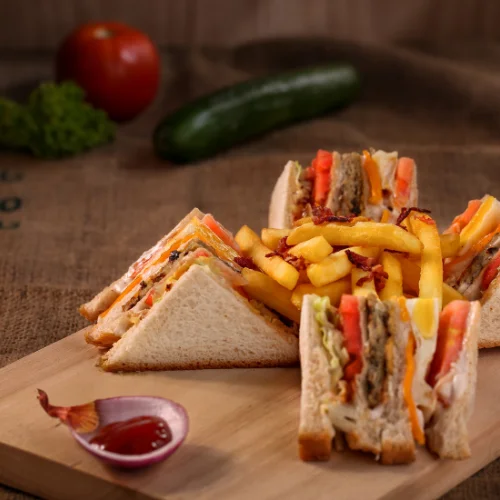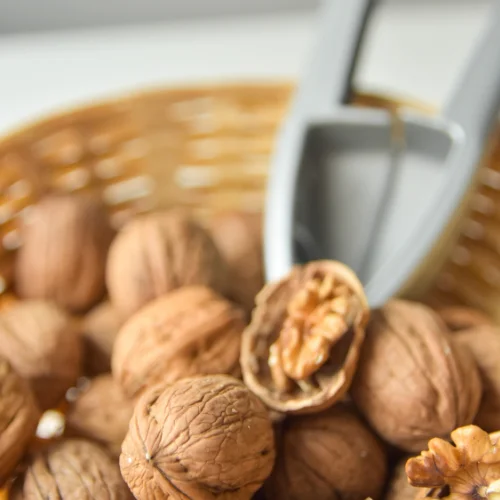10 Finger Foods for Dementia Patients: Nourishment Made Easy!
When our loved ones are dealing with dementia, it’s essential to provide them with nourishing and easily manageable meals. Finger foods come to the rescue, offering convenience, independence, and a delightful dining experience. So, let’s explore a list of 10 fantastic finger foods that will keep your loved ones’ taste buds satisfied and their spirits high!
Here’s the List of Finger Foods for Dementia Patients
1. Sliced Fruits

There’s nothing quite like the refreshing sweetness of juicy fruits to brighten someone’s day. Sliced fruits, such as watermelon, cantaloupe, or grapes, make excellent finger foods for dementia patients. These colorful treats are packed with essential vitamins and minerals while being easy to handle and eat. They can be enjoyed on their own or dipped in yogurt for added creaminess.
2. Cheese and Crackers

Who doesn’t love a classic combo of cheese and crackers? This timeless duo provides a perfect balance of flavors and textures. Choose mild cheese varieties like cheddar or Swiss, which are easier to chew and swallow. Combine them with whole-grain or gluten-free crackers to add a satisfying crunch. This finger food option is both simple to prepare and enjoyable to munch on!
3. Mini Quiches

When it comes to finger foods, mini quiches are a winning choice. These bite-sized delights can be packed with a variety of nutritious ingredients such as eggs, vegetables, and cheese. Bake them in muffin tins for convenient portion size. Not only are they delicious and easy to handle, but they also offer a good source of protein, making them a wholesome snack for dementia patients.
4. Vegetable Sticks with Dip

Getting in those daily veggies is a breeze with vegetable sticks and dip. Slice cucumbers, carrots, and bell peppers into manageable strips and serve them with a tasty dip like hummus or Greek yogurt mixed with herbs. This finger food option encourages self-feeding and provides a healthy dose of vitamins, minerals, and fiber to support overall well-being.
5. Mini Sandwiches

Mini sandwiches are a delightful choice for finger foods. You can create endless variations to suit your loved one’s preferences. Opt for soft bread, such as whole wheat or gluten-free, and fill them with ingredients like lean deli meats, cheese, or mashed avocado. Slice them into small, manageable portions, and secure them with toothpicks. These mini sandwiches are sure to make every bite a joy!
6. Yogurt Parfaits

Yogurt parfaits offer a blend of creaminess, crunch, and natural sweetness that dementia patients will relish. Layer Greek yogurt with fresh berries, granola, and a drizzle of honey for a delectable treat. The smooth texture of the yogurt and the combination of flavors make it an excellent option for those who may have difficulty with other solid foods.
7. Baked Chicken Tenders

Sometimes, a craving for something savory strikes, and baked chicken tenders come to the rescue. These tender strips of chicken are coated in a light breadcrumb or almond flour crust, then baked to perfection. They offer a healthier alternative to fried chicken while maintaining that satisfying crunch. Serve them with a side of dipping sauce for an extra burst of flavor!
8. Mini Meatballs

Mini meatballs are a versatile finger food option that can be enjoyed in various ways. Whether made from ground beef, turkey, or chicken, these bite-sized delights are easy to chew and packed with protein. Opt for softer textures by mixing in cooked vegetables or using a slow cooker to cook them until they’re tender. Serve them plain or with a sauce of your loved one’s choice, such as marinara or barbecue. These mini meatballs are sure to bring a smile to their faces and provide a satisfying dose of nourishment.
9. Soft-Baked Goods

Soft baked goods like muffins or banana bread can be modified to meet the needs of dementia patients. Opt for recipes that use healthier ingredients like whole wheat flour or oats and minimize added sugars. Incorporate fruits, nuts, or even vegetables like zucchini for added nutrition. Cut them into small, bite-sized pieces, and watch as your loved ones enjoy the familiar taste of homemade treats.
10. Trail Mix

For convenient and nutritious finger food, a trail mix is a perfect choice. Create a personalized blend by combining nuts, seeds, dried fruits, and even a few dark chocolate chips for a touch of indulgence. The combination of flavors and textures in trail mix provides a satisfying snack that can be enjoyed throughout the day. Pack them in small resealable bags for easy access and portion control.
How can finger foods help improve nutrition for individuals with dementia?
Dementia is a complex condition that affects millions of people worldwide, leading to cognitive decline and impairments in daily activities. As individuals with dementia face challenges in maintaining adequate nutrition, finding strategies to support their dietary needs becomes crucial.
Promoting Independence
Finger foods empower individuals with dementia to maintain a sense of independence and autonomy in their eating habits. By providing bite-sized portions, these foods eliminate the need for cutlery, allowing individuals to feed themselves without assistance. This self-feeding ability not only fosters a sense of accomplishment but also helps to preserve their fine motor skills.
Ensuring Adequate Nutrition
Incorporating finger foods into the diet of individuals with dementia can help ensure they receive essential nutrients. These foods can be tailored to include a variety of healthy options such as fruits, vegetables, lean proteins, and whole grains. By offering a colorful array of finger foods, individuals are more likely to consume a diverse range of nutrients necessary for their well-being.
Enhancing Oral Health
Chewing and swallowing difficulties often accompany dementia, making it challenging for individuals to consume regular foods. Finger foods, with their smaller and softer texture, reduce the risk of choking and make the eating experience more comfortable. Additionally, the act of chewing on finger foods can stimulate saliva production, promoting better oral health.
Stimulating Sensory Experience
Finger foods provide a unique opportunity to engage the senses of individuals with dementia. The varying textures, colors, and flavors of different finger foods can stimulate appetite and encourage individuals to eat more. The tactile experience of handling the food can also be soothing and comforting, fostering a positive eating environment.
Social Interaction and Engagement
Sharing finger foods with others can promote social interaction and create a sense of connection during mealtimes. The casual nature of finger foods encourages conversation and engagement, allowing individuals to feel more involved in their surroundings. This social stimulation can positively impact their overall well-being and mood.
Incorporating finger foods into the diet of individuals with dementia can significantly improve their nutrition and overall quality of life. These easily manageable bites promote independence, ensure adequate nutrition, enhance oral health, stimulate sensory experiences, and foster social interaction.
By offering a wide variety of finger foods, caregivers and healthcare professionals can make mealtimes more enjoyable, encouraging individuals with dementia to maintain a healthy and balanced diet.
Are there any specific textures or consistencies to consider when selecting finger foods for dementia patients?
When it comes to selecting appropriate finger foods for individuals with dementia, considering the textures and consistencies is essential. Dementia can often result in chewing and swallowing difficulties, making it crucial to choose foods that are easy to handle and consume.
Soft and Moist
Opting for finger foods with soft and moist textures is ideal for individuals with dementia. These foods are easier to chew and swallow, reducing the risk of choking or discomfort. Examples include cooked vegetables, ripe fruits, tender meats, and moist cakes. The moistness of these foods not only aids in swallowing but also enhances their palatability, making them more appealing to individuals with reduced appetite.
Minced or Ground
For individuals with severe chewing and swallowing difficulties, minced or ground finger foods are highly beneficial. These foods are finely chopped or pureed to create a smooth and manageable consistency.
Options such as minced meat, mashed potatoes, pureed soups, and smoothies provide essential nutrients while minimizing the effort required for consumption. The consistency can be adjusted to suit the individual’s needs, ensuring safety and ease of swallowing.
Bite-sized and Easy to Hold
Choosing finger foods that are bite-sized and easy to hold promotes independence and confidence during eating. Foods such as cut-up fruits, cheese cubes, bite-sized sandwiches, and crackers allow individuals to feed themselves without assistance. It is important to ensure that the pieces are small enough to avoid any potential choking hazards while still providing a satisfying eating experience.
Textural Variety
Offering a variety of textures in finger foods can stimulate sensory experiences and enhance the overall enjoyment of eating. Incorporating crunchy elements like raw vegetables, nuts, or crispy crackers can provide a pleasant contrast to softer foods. The combination of textures not only adds interest but also promotes the engagement of different senses, making the dining experience more enjoyable and stimulating.
Adapting to Individual Preferences
While general guidelines for textures and consistencies exist, it is crucial to consider individual preferences and abilities. Some individuals may have specific food preferences or require modifications due to dental issues.
Collaborating with healthcare professionals and caregivers to understand the specific needs and preferences of each individual ensures a personalized approach to selecting finger foods that promote optimal nutrition and enjoyment.
When choosing finger foods for individuals with dementia, considering textures and consistencies is crucial for their safety, comfort, and overall dining experience. Soft and moist options, minced or ground foods, bite-sized portions, and textural variety are key factors to consider.
By tailoring finger foods to individual preferences and needs, caregivers can create a positive and engaging mealtime environment, promoting adequate nutrition and enhancing the well-being of individuals with dementia.
Conclusion
And there you have it, folks! My fantastic list of 10 finger foods for dementia patients. Remember, these options prioritize convenience, nutrition, and sensory pleasure, all while promoting independence during mealtime. Experiment with different combinations and adaptations to cater to your loved ones’ unique tastes and dietary requirements.
By providing finger foods, we empower our loved ones to enjoy meals with ease and dignity, fostering a positive dining experience. So, go ahead and give these finger foods a try! Your loved ones will appreciate the thought and effort you put into their well-being.
Now, it’s your turn to join the conversation. Have you tried any finger foods for dementia patients? Which ones were a hit? Do you have any additional suggestions? Share your thoughts, experiences, and favorite recipes in the comments below. Let’s support and learn from one another in this journey of caring for our loved ones.
Remember, simple finger food can make a big difference in enhancing the quality of life for individuals with dementia. Let’s keep nourishing their bodies and souls, one delightful bite at a time!
What are your favorite finger foods for dementia patients? Share your experiences and suggestions!
